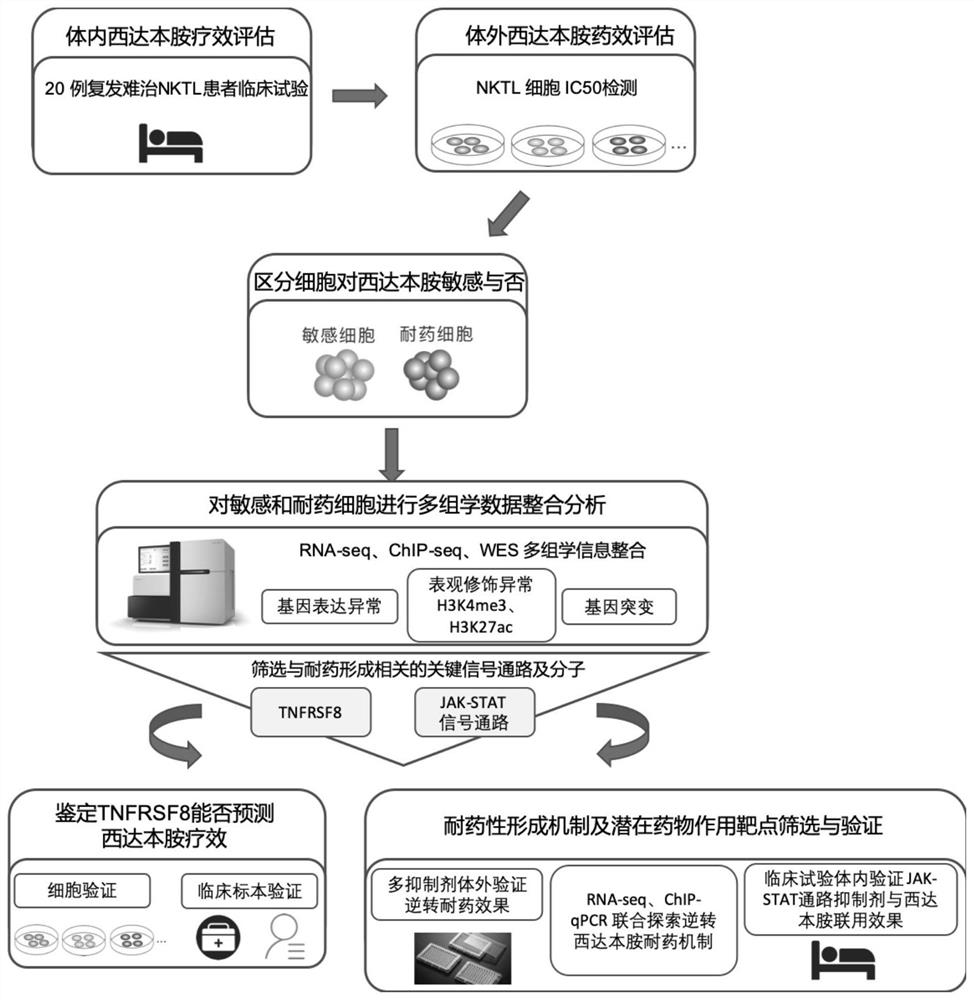A novel combination targeted drug for the treatment of relapsed/refractory T-cell lymphoma
A lymphoma and cell technology, applied in the field of medicine, can solve the problems of differences in curative effects that need to be deepened, and achieve the effect of improving the current situation of clinical treatment and increasing the survival rate
- Summary
- Abstract
- Description
- Claims
- Application Information
AI Technical Summary
Problems solved by technology
Method used
Image
Examples
Embodiment 1
[0047] Example 1 evaluates the therapeutic effect of Chidamide on NKTL
[0048] 1. Our team recruited 20 NKTL patients and conducted clinical trials using Chidamide.
[0049] In order to evaluate the efficacy of chidamide in the treatment of relapsed and refractory NKTL patients, we enrolled 20 relapsed and refractory NKTL patients in Sun Yat-sen University Cancer Center (SYSUCC) from August 2016 to April 2018. Phase II prospective clinical trial. Refractory was defined as not achieving PR or CR according to the evaluation criteria for malignant lymphoma (Lugano2014 criteria) after at least two cycles of chemotherapy. Relapsed and refractory NKTL patients aged 18-75 who received asparaginase-based chemotherapy or radiotherapy and chemotherapy, ECOG score ≤ 2, normal organ and bone marrow function, no serious hematopoietic function, cardiac , lung, liver, kidney, and thyroid dysfunction, and at least one measurable or assessable lesion is eligible for inclusion. Patients wit...
Embodiment 2
[0055] Example 2 Study on the killing effect of HDAC inhibitors such as chidamide on NKTL cells
[0056] 1. Our team detected the IC50 of Chidamide in 11 NKTL cell lines, and treated the 11 NKTL cells with three HDAC inhibitors Chidamide, TrichostatinA (TSA), and SAHA, and evaluated the cells by ATP detection On this basis, two sensitive and two drug-resistant NKTL cell lines were selected for follow-up research. The killing effect of chidamide on NKTL cells was further demonstrated through cell viability detection, cell cycle and cell apoptosis experiments.
[0057] NKTL cell line sources: HANK1 and YT were provided by Dr. Yoshitoyo Kagami and Dr. C. Clayberger, respectively. SNK6, SNT8, SNK1 and NKYS were provided by Dr. Norio Shimizu. MEC04 was provided by Dr. Paul Coppo and Dr. Philippe Gaulard. KHYG1 and KAI-3 were purchased from JCRB Cell Bank, NK92 was purchased from ATCC, and NK-S1 was constructed from one NKTCL xenograft.
Embodiment 3
[0085] Example 3 Perform chromatin immunoprecipitation sequencing and transcriptome sequencing on chidamide-resistant and sensitive NKTL cells, respectively
[0086] 1. Experimental method
[0087] H3K27ac is a marker of enhancer. Our team used two strains of sensitive and two strains of drug-resistant NKTL cells for H3K27ac ChIP-seq analysis, in order to analyze the chromatin in the state of tolerance to Chidamide. Gains and losses, and further combining RNA-seq and ChIP-seq data, identified signaling pathways enriched in chidamide-resistant states.
[0088] NKTL cell line source: KHYG1 was purchased from JCRB cell bank. MEC04 was provided by Dr. Paul Coppo and Dr. Philippe Gaulard. HANK1 was provided by Dr. Yoshitoyo Kagami. SNK6 was provided by Dr. Norio Shimizu.
[0089] Chromatin immunoprecipitation sequencing (Chip-seq): cells were collected, cross-linked with 1% formaldehyde for 10 min, and cross-linked with glycine. Centrifuge, wash the cells 3 times with TBSE, re...
PUM
 Login to View More
Login to View More Abstract
Description
Claims
Application Information
 Login to View More
Login to View More - R&D
- Intellectual Property
- Life Sciences
- Materials
- Tech Scout
- Unparalleled Data Quality
- Higher Quality Content
- 60% Fewer Hallucinations
Browse by: Latest US Patents, China's latest patents, Technical Efficacy Thesaurus, Application Domain, Technology Topic, Popular Technical Reports.
© 2025 PatSnap. All rights reserved.Legal|Privacy policy|Modern Slavery Act Transparency Statement|Sitemap|About US| Contact US: help@patsnap.com



